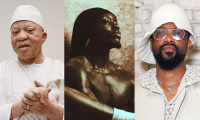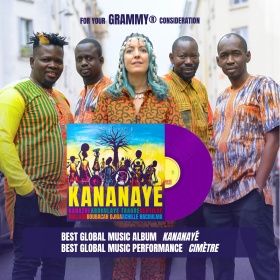Popular music and the challenges of freedom of expression in Kenya
By Mwenda Ntarangwi
Social media has sliced through the structures that moderated the way we create, access and consume popular music, impacting on all aspects of music production. And genre has not been spared.
 Kenya Film Classification Board CEO Ezekiel Mutua.
Kenya Film Classification Board CEO Ezekiel Mutua.
Here, context and register are in tension. In today’s world of social media and other forms of information sharing brought by accelerated access to information technology, it is hard to control what gets produced and distributed as popular culture. With increased access to information as well as ease with which to widely share it, Kenyans have found multiple ways of articulating their lived experiences and new forms of gaining public prominence.
For popular music creators, social media has emerged as the most important medium through which they construct their identities and products outside the control of the state, and of necessary review processes.
As Mbugua wa Mungai notes, expressive cultural forms availed through music, films and folklore allow Kenyans to “imagine their lives in ways other than those the politicians might desire”. No longer at the mercy of state machineries of control and regulation, some artists with an eye on easy paths to stardom sidestep proven paths of peer review to hastily produce songs that soon rub the public the wrong way. Just as their songs quickly gain popularity through online distribution, they also earn the wrath and scrutiny of the public as speedily, and easily.
Kenya’s popular musicians creating work in the genre often termed 'gospel' provide multiple examples of this phenomenon. Artists such as Jimmy Gait, Bahati, Size 8, and SBJ in 2016 gave Kenyans reason to question the identity of their music as 'gospel'. SBJ and Jimmy Gait in their respective songs ‘Nyonyo’ and ‘Yesu Ndie Sponsor’ are a case in point. Both songs drew a lot of criticism from Kenyans on social and broadcast media for their association of God and Jesus with terms or concepts that are operationally considered secular. In 'Nyonyo', for instance, SBJ sings, "Eeh Baba nipe nyonyo ooh Yesu niko tayari" (Eeh Father breastfeed me, ooh Jesus I am ready). The video for the song starts with an image of a large yellow plastic baby bottle with an inscription derived from 1 Peter 2:2, Nyonyo ya God is fresh. The referenced Bible verse reads: “Like newborn babies, crave pure spiritual milk, so that by it you may grow up in your salvation.” Nyonyo comes from the Kiswahili verb kunyonya (to suckle) and is a colloquial term children use to refer to their mother’s breast milk.
In ‘Yesu Ndie Sponsor’, Jimmy Gait plays with the newly mobilised meaning of the word “sponsor” that in Kenya today denotes a (mostly) sexual relationship between an older man or woman and a younger man or woman based on the material resources the former provides (sponsors) to the latter. In the song Jimmy Gait says that relationships built on sponsor/ship are short-lived and end up in sorrow. For him, the true sponsor is Jesus. If one were to listen to the content of the songs without specific reference to the 'controversial' words nyonyo and sponsor, then one might not consider them offensive in any way. Both artists have nevertheless apologised to those offended by the music even as they have defended their songs by clarifying the message they intended the music to convey.
This scenario begs the question of what makes a song acceptable as gospel or even as a product for public consumption in Kenya today. Is it the intended message as explained by the artist or the interpretation of message by its audiences? To answer this question we turn to the Universal Declaration of Human Rights, which guarantees the freedom of expression of all individuals. This right is also guaranteed in the Constitution of Kenya (Revised 2010) Chapter Four Part 1:33,2 granting every Kenyan the right to hold opinions without interference and to seek, receive and impart information and ideas through any media and regardless of frontiers.
And yet such freedom can only be mobilised in relation to the rights of others. As humans we are social beings, living in a world that functions well because of right relationships we have with others – fellow citizens, neighbours, co-workers, family members, etc. Having lived under a dictatorship for most of the country’s political independence, Kenyans ushered in the new Constitution on 27 August 2010 in the hope that it would not only provide a new era of freedom of expression but also help cultivate a new form of sociality.
That sociality has interacted both positively and negatively with the increasing advances in new technologies that have produced the social media phenomenon we witness today. On the one hand Kenyans are finding more spaces for self-expression and mobilisation of mass action in unprecedented ways. On the other, some of these expressions threaten social and moral decorum because of the ease with which they can be broadcast publicly without moderation or feedback.
Part of the complexity surrounding the songs referenced here can be seen in two ways: First is the interactions that are taking place between expanded information technology and livelihoods in urban spaces. For many popular artists the urban space provides a certain level of anonymity where new social codes of behavior are negotiated and relationships extend beyond familial or descent territories dominant in most rural communities. Second is the ease with which popular culture can be produced and broadcast by individuals without any real ways of vetting such productions.
The heightened level of competition for audience members, new ways of relating to each other and constantly changing forms of morality that are experienced by many urban populations also compel popular culture creators to push society’s moral envelope. Improved technology has seen music production become more and more an individual enterprise, and artists come to be their own peer reviewers and creative directors.
In such a set-up there is very little in terms of checks and balances. By its very nature, social media is itself averse to any forms of control and strives to provide freedom to share content broadly as long as one has access to that media. This is where a regulatory body is essential in assisting artists to anticipate some of the responses that popular music products might draw from their audience members. But such a regulatory body needs to operate within the parameters set by the Constitution. Attempts by the Kenya Film Classification Board (KFCB) to muzzle the creative industry in the country provide an example of how not to regulate the creative industry.
Mendel and Salomon’s overview of freedom of expression and broadcasting regulation provide a framework that might be useful for Kenyan popular culture. They argue that the right to freedom of expression “protects both the right of the speaker and the right of the listener” and that regulatory rules can be justified in some “cases to protect equality and children”.
Had there been a dialogue mediated by a regulatory body on behalf of SBJ and Jimmy Gait on the one hand and their audience members on the other, might the controversy that accompanied ‘Nyonyo’ and ‘Yesu Ndie Sponsor’ been avoided? Yes, as long as that regulatory body was constituted in consultation with all stakeholders and reflected a desire to balance artists’ creativity with agreed-upon forms of expressing such creativity. It is the kind of cultural creation around popular music in which all participants develop sensibilities that guide their production without the need to always be patrolled and vetted.
As Kenya grows its democratic ethos and as constitutionally guaranteed freedoms take root, there is need for constant conversations and consultations between artists and audience members, as well as government representatives and professional organisations. It is how good artistic products will grow and be sustained. Striking that fine balance in a world where the floodgates of cultural production are open and with no option for closure is a real exercise in negotiation.
Mwenda Ntarangwi is associate professor of anthropology based at Calvin College in the US. His professional and academic interests lie in how popular music explores and expresses social realities. He is also interested in cross-cultural learning and education, connecting people to appropriate resources. He has published extensively and in 2016 wrote The Street is my Pulpit: Hip Hop and Christianity in Kenya.
References
- See, Wa Mungai, Mbugua, 2010, "Iconic Representations of Identities in Kenyan Cultures" in Mbugua wa Mungai and G M Gona, eds, pp. 72-95, (Re)membering Kenya: Identity, Culture and Freedom. Nairobi: Twaweza Communications Ltd.
- The Constitution of Kenya 2010 edition pp. 26 available at http://www.kenyaembassy.com/pdfs/ the%20constitution%20of%20kenya.pdf accessed December 29, 2016.
- The Kenya Film Classification Board’s (KFCB) 2016 proposed bill for regulating films had included a clause that requires a police officer to be present during the filming of a film in Kenya. After a meeting and discussion of the bill with Kenyan creative community the bill was shelved until all stakeholders are consulted.
- See, Mendel Tony and Eve Salomon, 2011, “Freedom of Expression and Broadcasting Regulation,” CI Debates, No. 8, February 2011. Brasilia, Brazil: UNESCO. Available at http://unesdoc.unesco.org/ images/0019/001916/191623e.pdfaccessed January 6, 2017.
This article originally appeared in the Jahazi journal volume 6 issue 1 2017: An initiative by Twaweza Communications - Nairobi, and Bantu Mwaura, to encourage dialogue between academicians and art practitioners.















Commentaires
s'identifier or register to post comments